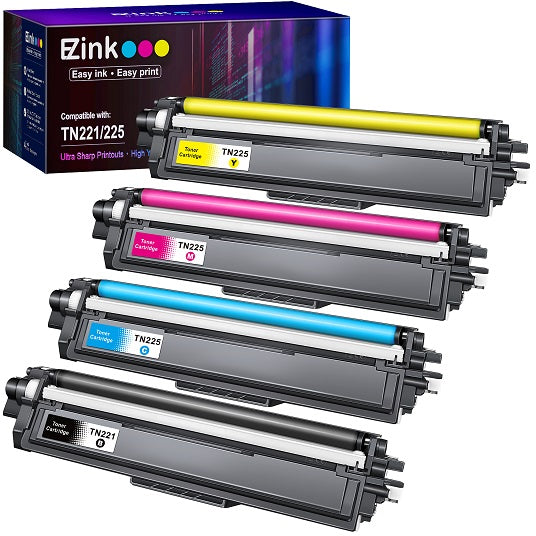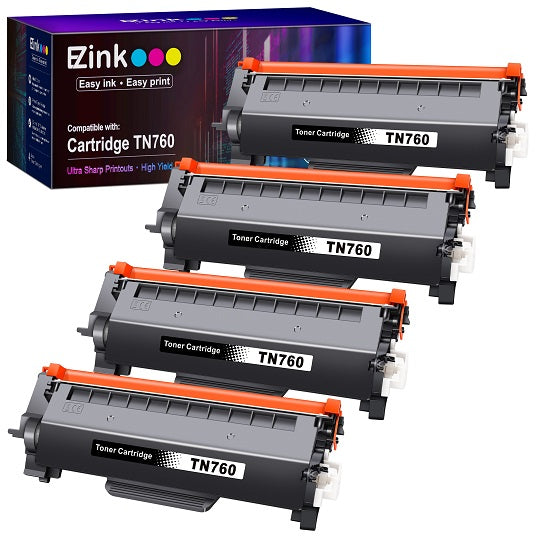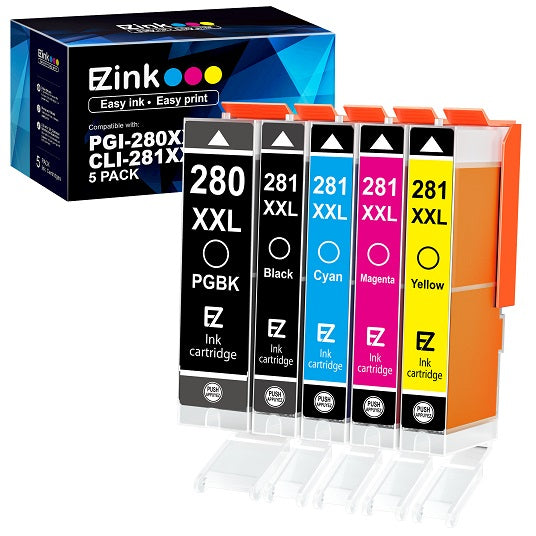Printer Ink vs. Toner What's the Difference and Which is Right for You
Posted on

One crucial aspect is the printer ink or toner, which determines the quality, durability, and cost-effectiveness of our printed materials. In this blog post, we will explore the differences between printer ink and toner, shedding light on their composition, benefits, drawbacks, and common applications. Additionally, we will guide you in making the right choice by considering various factors based on your unique needs and preferences. So, if you want to gain a better understanding of printer ink and toner and discover which option is best suited for you, join us on this informative journey. Together, we'll unravel the mysteries of printer ink and toner and empower you to make informed decisions about your printing needs.
Understanding Printer Ink
A. Definition of Printer Ink

Printer ink refers to a liquid or semi-liquid substance that is used by inkjet printers to produce printed output on paper or other materials. It consists of various pigments or dyes that provide the necessary color and a carrier fluid that facilitates the ink's smooth flow onto the printing surface. Printer ink is typically stored in cartridges or tanks within the printer and is applied to the paper through a series of nozzles or printheads.
B. Types of Printer Inks (Dye and Pigment Inks)

1. DyeInk
Dye ink is the most commonly used type of ink in inkjet printers. It is composed of small colored molecules dissolved in a liquid carrier. Dye inks are known for their vibrant and intense colors, making them ideal for printing photos and graphics that require high color accuracy and saturation. They also tend to be more affordable than pigment inks. However, dye inks may fade over time when exposed to light or moisture.
Let's say you want to print a colorful vacation photo. Using dye ink will offer you vivid and eye-catching results, capturing the intricate details and vibrant hues of the image.
2. Pigment Ink
Pigment ink contains microscopic solid particles, known as pigments, suspended in a liquid carrier. These particles are more resistant to fading and are absorbed into the printing material, creating a durable and long-lasting print. Pigment inks are often used for printing documents, text, and archival materials that require longevity. They produce sharp and crisp text with excellent resistance to water and fading. However, pigment inks are generally more expensive than dye inks and may result in prints with slightly muted colors compared to dye inks.
If you need to print important documents or projects that need to withstand environmental factors, such as sunlight or moisture, using pigment ink will ensure greater durability and longevity of the printed materials.
C. Advantages and Disadvantages of Printer Inks
1. Dye Ink Advantages

a. Vibrant Colors: Dye inks offer a wide color spectrum and deliver vibrant and eye-catching prints, making them perfect for photos and graphics.
b. Fast Drying: Dye inks tend to dry quickly, allowing for immediate handling of printed documents without the risk of smudging.
c. Affordability: Dye inks are generally less expensive than pigment inks, making them a cost-effective option for everyday printing needs.
2. Dye Ink Disadvantages
a. Fading: Dye inks can be more susceptible to fading over time, especially when exposed to light or moisture.
b. Smudging: Due to their fast-drying nature, dye inks may smudge or blur if exposed to water or if handled immediately after printing.
c. Longevity: Prints made with dye inks may not have the same longevity as those made with pigment inks.
3. Pigment Ink Advantages

a. Durability: Pigment inks are highly resistant to fading and offer excellent longevity, making them ideal for archival and long-lasting prints.
b. Water and Fade Resistance: Pigment inks are resistant to water and fading, ensuring that prints maintain their quality even when exposed to environmental factors.
c.Sharp Text Prints: Pigment inks produce sharp and crisp text, guaranteeing professional-looking documents.
4. Pigment Ink Disadvantages
a. Cost: Pigment inks are generally more expensive than dye inks, which may be a consideration for users with high-volume printing needs.
b. Less Vibrant Colors: While pigment inks provide excellent text and durability, they might produce prints with slightly muted colors compared to dye inks.
D. Common Uses and Compatibilit
Both dye and pigment inks have their specific applications and compatibility:
1. Dye Ink Uses and Compatibility
a. Photos: Dye inks are commonly used for printing high-quality photos due to their ability to produce vivid colors and detail.
b. Graphics and Artwork: Dye inks are also suitable for printing graphics, artwork, and illustrations, where color accuracy and vibrancy are crucial.
c. Compatibility: Dye inks are compatible with most inkjet printers, as they are widely available and commonly used.
2. Pigment Ink Uses and Compatibility
a. Documents and Text Prints: Pigment inks are preferred for printing documents and text-intensive materials, as they offer excellent readability and longevity.
b. Archival Prints: Pigment inks are ideal for printing archival materials that require long-term preservation and resistance to fading.
c. Compatibility: Pigment inks are compatible with specific inkjet printers designed to handle their thicker consistency. It is essential to check printer compatibility or use ink cartridges recommended by the printer manufacturer to ensure optimal performance.
Exploring Toner
A. Definition of Toner

Toner is a dry, powdery substance or liquid used in laser printers and photocopiers to create high-quality printed documents. It consists of a mixture of finely ground plastic particles, colorants, and other additives. Toner is stored in cartridges that are inserted into the printer or copier. When printing, the toner is transferred electrostatically onto the paper and then fused onto the paper using heat or pressure.
B. Types of Toner (Powdered Toner and Liquid Toner)
1. Powdered Toner
Powdered toner is the most common type of toner used in laser printers and photocopiers. It is made up of fine plastic particles mixed with colorants. This dry powder is electrically charged to adhere to the electrostatically charged areas on the paper. Powdered toner provides excellent print quality and sharp text.
Example: When printing a document using a laser printer, powdered toner particles are attracted to the areas that need to be printed. The toner particles fuse to the paper, creating high-resolution text and images.
2. Liquid Toner

Liquid toner, also known as polymer-based toner, is a less commonly used type of toner. It is composed of microscopic particles suspended in a liquid carrier. Liquid toner is predominantly used in high-end commercial printers and copiers that utilize a liquid electro-photographic printing process. The liquid toner is applied to a photoreceptor drum and then transferred onto the paper.
Example: In a professional printing environment, a high-speed commercial printer may use liquid toner to quickly and efficiently print large volumes of documents with precise details and vibrant colors.
C. Advantages and Disadvantages of Toner:
1. Advantages of Toner

a. High-Quality Prints: Toner produces sharp and crisp prints, making it ideal for text-heavy documents and professional-quality graphics.
b. Durability: Toner prints are highly resistant to smudging and fading, ensuring long-lasting prints that can withstand handling and environmental factors.
c. Fast Printing: Toner-based printers can produce prints at a rapid speed, making them suitable for high-volume printing needs.
d. Efficient: Toner cartridges have a higher page yield, meaning they can produce a larger number of prints before needing to be replaced compared to ink cartridges.
2. Disadvantages of Toner
a. Equipment Cost: Laser printers and copiers that use toner tend to be more expensive upfront compared to inkjet printers.
b. Initial Warm-up Time: Laser printers often require a short warm-up period before producing the first print, which may cause a slight delay for urgent printing tasks.
c. Limited Color Range: While toner is excellent for black and white prints and documents with simple color elements, achieving a wide color gamut can be challenging.
D. Common Uses and Compatibility:
1. Documents and Text Prints
Toner is widely used in offices for printing business documents, reports, and other text-intensive materials. Its high-quality text output ensures clear and professional-looking prints.
2. Marketing Collaterals
Toner is suitable for printing marketing materials such as brochures, flyers, and presentations, as it produces high-resolution graphics and fine details.
3. Compatibility
Toner is used in laser printers and photocopiers specifically designed for toner-based printing processes. These printers are often more compatible with plain paper and can handle higher volumes of printing compared to inkjet printers.
Factors to Consider When Choosing Between Printer Ink and Toner
A. Printing requirements (volume, speed, and quality)
1. Determine your printing volume

If you have high printing needs, such as in an office, consider ink or toner cartridges with higher page yields. For example, if you print a lot of documents, a toner cartridge with a page yield of 2,500 pages might be more suitable than one with a yield of 1,000 pages.
2. Consider printing speed
If you require fast printing, choose ink or toner cartridges that are compatible with printers known for their high printing speed. For instance, if you need quick turnaround times, a high-speed Brother HL-L2300D Laser printer with a E-Z Ink Toner Cartridge Replacement for Brother TN660 TN630 High Yield would be a good choice.
Brother HL-L2300D Laser printer

Brother TN660 TN630 Compatible Toner Cartridge (4 Black)
Click on the image to learn more
3. Evaluate print quality requirements
If you need professional-quality prints, such as for presentations or marketing materials, opt for ink or toner cartridges known for their excellent print quality. For example, a high-quality inkjet printer with pigment-based ink can deliver sharp and vibrant images.
For example: If you are a photographer who regularly prints high-resolution photos, you can choose a photo inkjet printer that uses specialized cartridges.
For example, the E-Z Ink Canon PGI-280XXL CLI-281XXL, developed for the Canon Pimax series, is a brightly colored cartridge designed to accurately reproduce photos. This allows you to meet your specific printing requirements and get professional-quality prints.
(Click on the image to learn more)
4. Check for compatibility
Ensure that the ink or toner cartridge you choose is compatible with your printer model. Using incompatible cartridges can lead to poor print quality or damage to your printer.
B. Budget considerations (cost per page and upfront costs)
When choosing printer ink or toner based on cost per page and upfront cost, it's essential to consider both factors to determine the overall cost-effectiveness. Here are some specific examples that can be used as references:
1. Example for inkjet printers:
Printer Model: Canon PIXMA MX922
Original Cartridge: Canon PGI-250XL/CLI-251XL High Yield Ink Cartridges (Black, Cyan, Magenta, Yellow)

Cost per Page Calculation:
- Black cartridge yield: 500 pages
- Color cartridges yield: 300 pages each
- Price of the original cartridge set: $70
Cost per Page (CPP) for Black ink:
CPP = (Price of the cartridge / Black cartridge yield) = ($70 / 500) = $0.14
Cost per Page (CPP) for Color ink:
CPP = (Price of the cartridge / Color cartridge yield) = ($70 / 300) = $0.23
Alternative Option:
Compatible Cartridges: Consider third-party compatible cartridges like the E-Z Ink Compatible Ink Cartridge Replacement for Canon PGI-250XL/CLI-251XL.

Cost per Page (CPP) for Compatible Cartridges:
E-Z Ink Canon 250 251 PGI-250XL CLI-251XL Compatible Cartridge Replacement as an Example
- Black cartridge yield: 600 pages
- Color cartridges yield: 350 pages each
- Price of the Ink Cartridge set: $20
CPP for Black ink:
CPP = (Price of the cartridge / Black cartridge yield) = ($20 / 600) = $0.03
CPP for Color ink:
CPP = (Price of the cartridge / Color cartridge yield) = ($20 / 350) = $0.06
In this example, the compatible cartridges offer a lower cost per page, making them a more cost-effective option upfront.
2. Example for laser printers:
Printer Model: Brother HL-L2380DW
Original Toner: Brother TN660 High Yield Toner Cartridge

Cost per Page Calculation:
- Toner cartridge yield: 2,600 pages
- Price of the original toner cartridge: $55
Cost per Page (CPP) for Toner:
CPP = (Price of the toner cartridge / Toner cartridge yield) = ($55 / 2,600) = $0.02
Alternative Options:
Compatible Toner: Look for compatible toner cartridges like the E-Z Ink Compatible Toner Cartridge Replacement for Brother TN660.

Cost per Page (CPP) for Compatible Toner:$25.
- Toner cartridge yield: 2,600 pages
- Price of the toner cartridge: $16
CPP for Compatible Toner:
CPP = (Price of the toner cartridge / Toner cartridge yield) = ($16 / 2,600) = $0.0062 (approximately $0.01)
In this example, the compatible toner cartridge offers a significantly lower cost per page and is a more budget-friendly option upfront.
While cost per page is a crucial factor, also consider the reputation and customer reviews of the compatible options to ensure quality and compatibility with your printer.
C. Environmental impact (recycling and waste generation)
When selecting printer ink or toner based on environmental factors, here are some guidelines to follow:
1. Look for Remanufactured ink cartridges
Opt for ink or toner cartridges that are made from recycled materials. These cartridges help minimize waste and conserve resources. Look for brands that offer cartridges made from recycled materials or those that promote their eco-friendly manufacturing processes.
2. Check for Recycling Programs
Check if the cartridge manufacturer has a recycling program in place. This allows you to return used cartridges for proper recycling. Look for brands that offer convenient and accessible options for recycling their cartridges, ensuring they are properly disposed of or reused.
Learn more about E-ZInk's recycling program: https://www.ezink123.com/pages/recycle-selection
3. Energy Efficiency
Opt for printers that prioritize energy efficiency. Look for printers with Energy Star certification, which signifies that they meet strict energy efficiency guidelines. Energy-efficient printers consume less power during operation, helping to reduce overall energy usage and environmental impact.
Selecting a printer can be referred to in previous articles,connecting to:
Smart Printing: How to Maximize Efficiency and Save Costs
Inkjet vs Laser Printers: Choosing the Perfect Printer for Your Needs
4. Research Brand Environmental Initiatives
Research the environmental initiatives of different printer ink or toner brands. Explore brands that prioritize sustainability, use eco-friendly manufacturing practices, or engage in environmental stewardship. Brands with a clear commitment to reducing their environmental impact may provide a more sustainable choice.

By considering these factors and conducting thorough research on brands and their environmental practices, you can choose printer ink or toner that aligns with your environmental values and reduces your ecological footprint.
Common Myths and Misconceptions
A. Dispelling misconceptions about printer ink and toner
Providing accurate information for informed decision-making about printer ink and toner is crucial. Here are some important points to consider:
1. Clarifying Misconceptions
a. Misconception: "Using third-party ink or toner will damage my printer."
- Clarification: While some low-quality third-party cartridges may cause issues, reputable third-party brands offer reliable, high-quality products that perform well without damaging printers. It's essential to do research, read reviews, and choose trusted third-party options.
b. Misconception: "Using compatible cartridges voids my printer's warranty."
- Clarification: The Magnuson-Moss Warranty Act protects consumers, and manufacturers cannot void warranties solely based on using compatible cartridges. Warranty claims can still be made if the issue is not directly caused by the compatible cartridge.
B. Addressing common concerns and doubts
a. Question: "Why are original manufacturer cartridges more expensive than third-party options?"
- Answer: Original manufacturer cartridges often involve substantial research, development, and marketing costs, which are reflected in their pricing. Third-party cartridges can offer equivalent performance at a lower cost as they don't have these additional expenses.
b. Concern: "Will using refilled or remanufactured cartridges compromise print quality?"
- Response: The print quality of refilled or remanufactured cartridges can vary. Reputable refillers and remanufacturers adhere to strict quality control measures to ensure performance is on par with original cartridges.
C. Providing accurate information for informed decision-making
a. Information: "Printer ink and toner cartridges can be recycled."
- Explanation: Many manufacturers have convenient recycling programs where used cartridges can be returned for proper recycling. Recycling helps minimize waste and conserves resources.
b. Information: "Refilling ink cartridges can be an eco-friendly option."
- Explanation: Refilling ink cartridges can be a sustainable choice as it reduces the need for new cartridges. By refilling cartridges multiple times, the number of cartridges produced and discarded decreases. Local refill stations and refill kits are available for this purpose.
Providing accurate information, clarifying misconceptions, and addressing common questions and concerns empower individuals to make well-informed decisions regarding printer ink and toner.

In conclusion, understanding the differences between printer ink and toner is essential for selecting the right option based on your printing needs. Printer ink is ideal for vibrant, high-quality color prints, while toner is perfect for sharp, precise text and high-volume printing. Factors such as print volume, cost, and printer type should be taken into account when making a decision. It's crucial to dispel common misconceptions about third-party cartridges and warranty concerns. By being well-informed and considering your specific requirements, you can confidently choose between printer ink and toner, achieving optimal printing results while being mindful of your budget and environmental impact.
Share this post

ENTER YOUR EMAIL
Subscribe to obtain $5 off Coupon!
loading...
WELCOME BACK!
You're already on the list
Take $5
as a thank you for comming
USE CODE: Newez123






